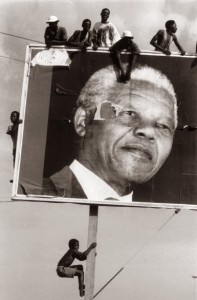Nelson Mandela’s greatness as a fighter against apartheid and crusader for justice in South Africa was much

Ian Berry, British, b. 1934. 1994, Lamontville. Supporters awaiting the arrival of Mandela in a Natal township. Gelatin silver print. Funds provided by Mike Schewel and Priscilla Burbank, 2011.205.
celebrated, fortunately, during his lifetime and will stand for the ages as an inspiration to the world. His battle was not easy, but he never bowed or swerved, and four years after his release in 1990 from twenty-seven years of incarceration on Robben Island he was elected President in South Africa’s first free election. Running as the candidate of the African National Congress party, Mandela’s campaign electrified the nation and crowds thronged to see their future leader wherever he went.
Photographer Ian Berry closely followed Mandela’s campaign, documenting this historic time through the lens of his camera. In one of the most marvelous images from the campaign period, Berry captured the excitement surrounding Mandela as young boys climbed upon a billboard bearing a huge picture of the candidate. Clinging to the Mandela image, they look out as if riding with his spirit.
Berry’s description of the photo reads: South Africa. Lamontville. Suporters climb to every vantage point whilst awaiting the arrival of Nelson Mandela in a Natal township, 1994.
This poignant image connects us with the dramatic times in early 1994 leading up to the three day voting period when people patiently and expectantly waited in long, snaking lines to cast their ballots.
There is a special story about Mandela’s own vote which has a background echo for Virginia. To cast his ballot, Mandela traveled to the Ohlange School, outside Durban. He chose to vote there as a tribute to John Dube, who was the progenitor and first President of the African National Congress in 1912—a man Mandela considered a founding figure in the fight for democracy. Dube fervently believed that education was key to liberation, and he was inspired to build the Ohlange Native Industrial Institute through his contact with Booker T. Washington and following the model of Hampton University, Washington’s alma mater, and Tuskegee University, which Washington established.
After casting his ballot, Mandela walked outside the school to visit John Dube’s grave, where he declared, “Mr. President, I have come to report to you that South Africa is free today.”
A similar message of profound simplicity also befits Mandela for his leading role in the fight for justice and reconciliation not just in South Africa, but as an example for all who would take notice throughout the world. As we gaze upon Ian Berry’s quite magical image we, too, can climb aboard and ride with this extraordinary human being.
-Richard B. Woodward
Curator of African Art